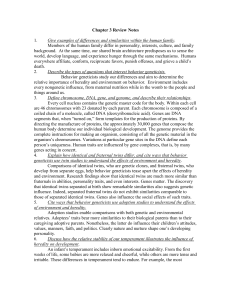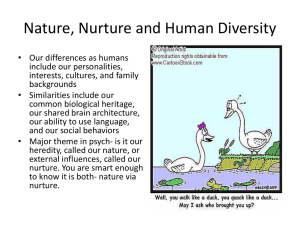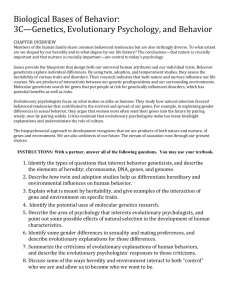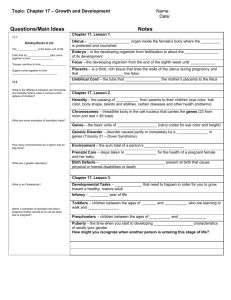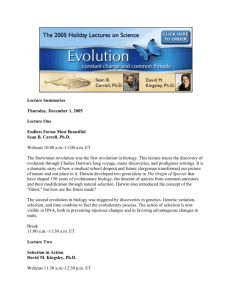File - Thrive in AP Psychology
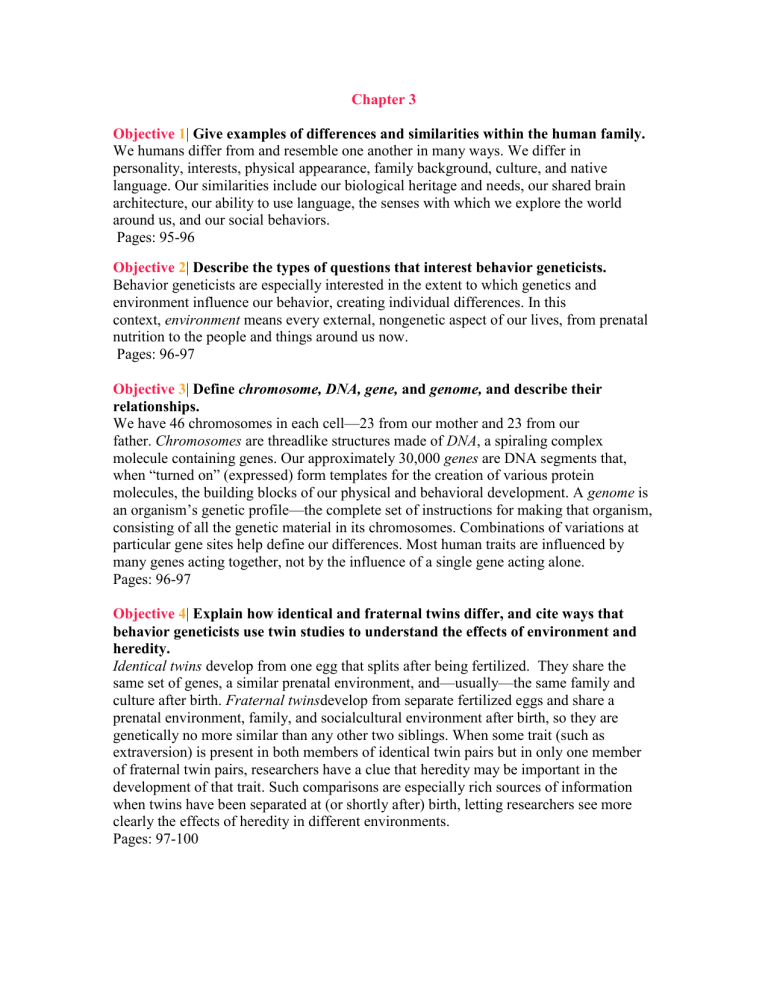
Chapter 3
Objective 1 | Give examples of differences and similarities within the human family.
We humans differ from and resemble one another in many ways. We differ in personality, interests, physical appearance, family background, culture, and native language. Our similarities include our biological heritage and needs, our shared brain architecture, our ability to use language, the senses with which we explore the world around us, and our social behaviors.
Pages: 95-96
Objective 2 | Describe the types of questions that interest behavior geneticists.
Behavior geneticists are especially interested in the extent to which genetics and environment influence our behavior, creating individual differences. In this context, environment means every external, nongenetic aspect of our lives, from prenatal nutrition to the people and things around us now.
Pages: 96-97
Objective 3 | Define chromosome, DNA, gene, and genome, and describe their relationships.
We have 46 chromosomes in each cell—23 from our mother and 23 from our father. Chromosomes are threadlike structures made of DNA , a spiraling complex molecule containing genes. Our approximately 30,000 genes are DNA segments that, when “turned on” (expressed) form templates for the creation of various protein molecules, the building blocks of our physical and behavioral development. A genome is an organism’s genetic profile—the complete set of instructions for making that organism, consisting of all the genetic material in its chromosomes. Combinations of variations at particular gene sites help define our differences. Most human traits are influenced by many genes acting together, not by the influence of a single gene acting alone.
Pages: 96-97
Objective 4 | Explain how identical and fraternal twins differ, and cite ways that behavior geneticists use twin studies to understand the effects of environment and heredity.
Identical twins develop from one egg that splits after being fertilized. They share the same set of genes, a similar prenatal environment, and—usually—the same family and culture after birth. Fraternal twins develop from separate fertilized eggs and share a prenatal environment, family, and socialcultural environment after birth, so they are genetically no more similar than any other two siblings. When some trait (such as extraversion) is present in both members of identical twin pairs but in only one member of fraternal twin pairs, researchers have a clue that heredity may be important in the development of that trait. Such comparisons are especially rich sources of information when twins have been separated at (or shortly after) birth, letting researchers see more clearly the effects of heredity in different environments.
Pages: 97-100
Objective 5 | Cite ways that behavior geneticists use adoption studies to understand the effects of environment and heredity.
Adopted children carry the genetic inheritance from their biological parents into an environment created by their adoptive families. Similarities between the child and the biological relatives give clues to the influence of heredity. Similarities between the child and the adoptive relatives give clues to the influence of environment. Adopted children tend to resemble their biological parents in their personality (their characteristic pattern of thinking, feeling, and acting), and their adoptive parents in their values, attitudes, manners, faith, and politics.
Pages: 100-101
Objective 6 | Discuss how the relative stability of our temperament illustrates the influence of heredity on development.
Temperament, a person’s characteristic level of emotional reactivity and intensity, is apparent soon after birth and tends to continue relatively unchanged into adulthood. This suggests that heredity plays a much larger role than environment in the development of temperament.
Pages: 102
Objective 7 |
Discuss heritability’s application to individuals and groups, and explain what we mean when we say genes are self-regulating.
Heritability describes the extent to which variation among individuals can be attributed to genes. It applies only to differences among individuals— never to any one person . In an imaginary experiment that could create identical environments, any observed differences
(in, for example, weight) among people would be the result of their heredity, and heritability would be 100 percent for that trait. Heritable individual differences in traits such as height or intelligence need not explain group differences. Genes mostly explain why some are taller than others, but not why people today are taller than a century ago.
Saying that genes are self-regulating means that genes are not blueprints; they can react differently in different environments.
Pages: 102-104
Objective 8 | Give an example of a genetically influenced trait that can evoke responses in others, and give another example of an environment that can trigger gene activity.
Some human traits (such as having two eyes) develop in any environment, but many important psychological traits are a product of the interaction of our genetic predispositions and our surrounding environment. A stressful environment, for example, can trigger genes that affect the production of neurotransmitters contributing to depression. And a genetic predisposition that causes a child to be restless and hyperactive can evoke angry responses from parents or teachers.
Pages: 104-105
Objective 9 | Identify the potential promise and perils of molecular genetics research.
Molecular geneticists study the molecular structure and function of genes in search of those that influence behaviors. Psychologists and molecular geneticists are cooperating in a search to identify specific genes—or more often, teams of genes—that put people at
risk for disorders. Knowledge of such links will enable medical personnel to inform expectant parents of some situations in which a fetus deviates from normal patterns. The ethical implications of such choices will be debated if parents choose to abort children who do not conform to their image of an ideal child.
Pages: 105-106
Objective 10 | Describe the area of psychology that interests evolutionary psychologists.
Evolutionary psychologists attempt to understand how natural selection has shaped behaviors found throughout the human species.
Pages: 107
Objective 11 | State the principle of natural selection, and point out some possible effects of natural selection in the development of human characteristics.
The principle of natural selection states that, among the range of possible variations in an inherited trait, the variations most likely to be passed on to future generations are those that increase the odds of reproducing and surviving. Genes that enabled a capacity to learn and to adapt had survival value for our ancestors, as did those that prepared people to survive in feast-or-famine conditions. We suffer the effects of famine less often, thanks to modern technology, but with a genetic legacy that causes us to store fat and a decrease in rigorous exercise, we become obese. Charles Darwin, whose theory of evolution has for a long time been an organizing principle in biology, anticipated the contemporary application of evolutionary principles in psychology.
Pages: 107-108
Objective 12 | Identify some gender differences in sexuality.
Gender refers to the biologically and socially influenced characteristics by which we define male and female. Men and women differ in their attitudes toward sex: Men are more approving of casual sex, think about sex more often, and are more likely to misinterpret friendliness as sexual interest. Women are more likely to cite affection as a reason for first intercourse and to have a relational view of sexual activity. Similar differences appear in sexual behavior. Men masturbate more often, initiate sexual activity more frequently, and make more sacrifices to gain sex.
Pages: 110-111
Objective 13 | Describe evolutionary explanations for gender differences in sexuality.
Applying principles of natural selection, evolutionary psychologists interpret human sexual behavior in terms of its survival value—the tendency for behaviors to be selected if they increase the likelihood of sending one’s genes into the future. Thus, being attracted to multiple healthy, fertile appearing partners increases men’s chances of spreading their genes widely and reproducing. Because women incubate and nurse babies, they increase their own and their children’s chances of survival by searching for mates with economic resources and social status, who have the potential for long term mating and investment in their joint offspring.
Pages: 111
Objective 14 | Summarize the criticisms of evolutionary explanations of human behaviors, and describe the evolutionary psychologists’ responses to those criticisms.
One criticism is that evolutionary psychologists start with an effect and work backward to an explanation. Another is that the evolutionary perspective underestimates cultural expectations and socialization. A third is that the evolutionary viewpoint absolves people from taking ethical and moral responsibility for their sexual behavior. Evolutionary psychologists respond that understanding our predispositions can help us overcome them.
They also cite the value of testable predictions based on evolutionary principles, as well as the coherence and explanatory power of those principles.
Pages: 112-113
Objective 15 | Describe some of the conditions that can affect development before birth.
Prenatal environments differ in terms of nutrition and exposure to toxic agents. Even identical twins sharing a placenta can, because of their differing locations, have unequal access to nourishment and protection from viruses.
Pages: 114
Objective 16 | Describe how experience can modify the brain.
During maturation, a child’s neural connections increase in areas associated with repetitive activities (vision, for example). Unused synapses degenerate, as happens in the brain cells normally assigned to vision in the cortex of children with congenital and untreated cataracts. Though the process is most evident in the brains of young children, growth and pruning of synapses continue throughout life.
Pages: 114-116
Objective 17 | Explain why we should be careful in attributing children’s successes and failures to their parents’ influence.
Freudian psychiatry and extreme environmentalism in early psychology contributed to the idea that parents shape their children’s futures. Parents do influence some areas of their children’s lives, such as their manners and political and religious beliefs. But in other areas, such as personality, the environment siblings share at home accounts for less than 10 percent of their differences.
Pages: 116-117
Objective 18 | Evaluate the importance of peer influence on development.
Children, like adults, attempt to fit into groups by conforming. But children also seek out others who share their attitudes and interests; this selection effect contributes to peer group uniformity. Parents and peers are complementary influences in children’s lives.
Parents are important models for education, discipline, responsibility, orderliness, charitableness, and ways of interacting with authorities. Peers are influential in such areas as learning to cooperate with others, achieving popularity, and finding appropriate styles of interaction with people of a similar age. By choosing the neighborhoods in which their children live, parents can exert some influence over the peer group culture that helps shape children.
Pages: 117-118
Objective 19 | Discuss the survival benefits of culture.
Culture is a set of enduring behaviors, ideas, attitudes, values, and traditions shared by a group of people and transmitted from one generation to the next. Culture and our capacity for language let us preserve innovations and pass them on to the next generation, a process that encourages diversity between groups. Despite cultural differences, our shared capacity for culture is a common thread running throughout the human species.
Pages: 119
Objective 20 | Describe some ways that cultures differ.
Cultures vary in their ideas, attitudes, values, and traditions. Those variations are embedded in each culture’s norms, its rules for accepted and expected behavior.
Newcomers or visitors to a culture different from their own may experience culture shock—confusion or frustration caused by their lack of understanding of the norms for observing personal space, expressing personal feelings, maintaining a faster or slower pace of life, or educating and caring for children.
Pages: 120-121
Objective 21 | Explain why changes in the human gene pool cannot account for culture change over time.
Cultures change rapidly. Western cultures, for example, have changed as they have discovered and adapted to new forms of technology. Cultures also change in their values, attitudes, and behaviors. The speed at which such changes occur is much faster than the slow pace of evolutionary changes in the human gene pool.
Pages: 121
Objective 22 | Identify some ways a primarily individualist culture differs from a primarily collectivist culture, and compare their effects on personal identity.
Cultures based on self-reliant individualism, like those of most of the United States,
Canada, and Western Europe, value personal independence and individual achievement.
Relationships tend to be more temporary and casual, confrontation is acceptable, and morality is self-defined. Individualist cultures tend to define identity in terms of selfesteem, personal goals and attributes, and personal rights and liberties. Cultures based on socially connected collectivism, like those of many parts of Asia and Africa, value interdependence, tradition, and harmony. Relationships tend to be few, close, and enduring, and morality is based on duty to one’s social network. Collectivist cultures tend to define identity in terms of group goals and commitments and belonging to one’s group.
Pages: 121-123
Objective 23 | Describe some ways that child-rearing differs in individualist and collectivist cultures.
Individualist cultures expect their members to be independent and to think for themselves, and child-rearing practices in those cultures reflect these values. Collectivist cultures, which emphasize a stronger sense of family self, tend to focus more on developing a sense of emotional closeness.
Pages: 124-125
Objective 24 | Describe some ways that humans are similar, despite their cultural differences.
Although we humans differ in our cultures, we share the same genetic profile, life cycle, capacity for language, biological needs, and need to belong. To the extent that biology and social forces predict behavior in individuals in one group, they often predict similar behaviors in those in other groups.
Pages: 125
Objective 25 | Identify some biological and psychological differences between males and females.
The major way human males and females are similar is in their genetic makeup, where 45 of 46 chromosomes are unisex. Males and females differ biologically in body fat, muscle, height, age of onset of puberty, and life expectancy. They also differ psychologically, for example, in their vulnerability to certain disorders: More women are diagnosed with depression, more men with antisocial personality disorder.
Pages: 126-127
Objective 26 | Summarize the gender gap in aggression.
Men more than women behave aggressively and describe themselves as aggressive. The aggression gender gap appears in many cultures and at various ages, especially for physical aggression.
Pages: 127
Objective 27 | Describe some gender differences in social power.
In most societies, men are socially dominant and are perceived as such. Men tend to occupy more leadership positions, and their leadership style is more directive than women’s.
Pages: 127-128
Objective 28 |
Discuss gender differences in connectedness, or the ability to “tend and befriend.”
Women, more than men, are concerned with making connections with others. This difference is noticeable in young children’s play, and it continues throughout the teen years and into adulthood. Women tend and befriend—they emphasize caring, often being responsible for the very young and very old. Bonds between women seem stronger and more supportive than those between men. Men tend to emphasize freedom and selfreliance.
Pages: 128-129
Objective 29 | Explain how biological sex is determined, and describe the role of sex hormones in biological development and gender differences.
Biological sex is determined by the twenty-third pair of chromosomes. In this pair, the mother’s contribution is always an X chromosome. The father’s contribution—which determines whether a child will be male or female—can be either an X or a Y. An XX combination produces a female; an XY combination produces a male. The Y chromosome contains a master switch for the production of the hormone testosterone, which triggers the growth of external male sex organs in the seventh week of prenatal
development. (Females also produce testosterone, but less of it.) The fourth and fifth prenatal months are a second key period for sexual differentiation, influenced by a male fetus’ greater testosterone or a female fetus’ ovarian hormones. Gender is defined as the set of biologically and socially influenced characteristics by which people define male and female. Sex-related genes and hormones do influence gender differences in behavior, possibly by influencing brain development, but many gender differences are learned.
Pages: 129-130
Objective 30 | Discuss the importance of environment in the development of gender roles, and describe two theories of gendertyping.
Our biology influences our gender, but cultures shape gender roles—expectations about how men and women should behave. Gender roles can vary from one place to another, and from one time to another within the same culture. A person’s sense of being male or female is called gender identity, and some people more than others exhibit gender-typed
(traditionally masculine or feminine) behavior. Social learning theory proposes that we learn gender behavior as we learn other things—through reinforcement, punishment, and observation. Gender schema theory proposes that we learn a cultural “recipe” of how to be male or female, which influences our behaviors and perceptions of what is appropriate for “people like us.”
Pages: 131-133
Objective 31 | Describe the biopsychosocial approach to development.
Our biology—established through natural selection as members of the human species or through our unique genetic combination at the time of our conception—provides us with certain abilities and places limits on others. The people and customs in our social environment direct us toward specific roles and reward us for conforming (or punish us for not conforming) to cultural expectations. Our individual biological and psychological characteristics also evoke reactions from those around us, which then influence our behavior. But our choices matter, too. We can study development from any point on this biopsychosocial continuum. Rather than diminishing us, science can enlarge our understanding of ourselves and our appreciation of the world around us.
Pages: 134-136
